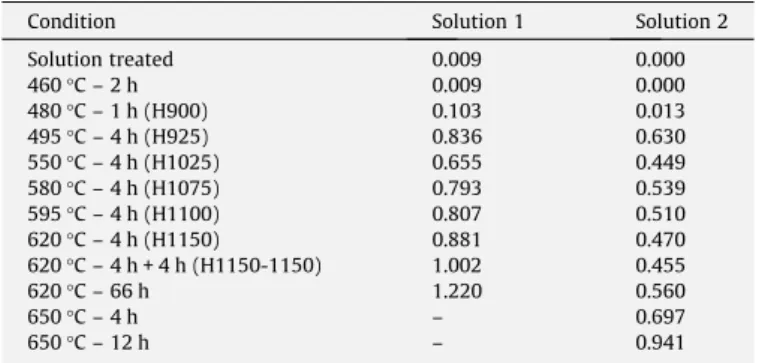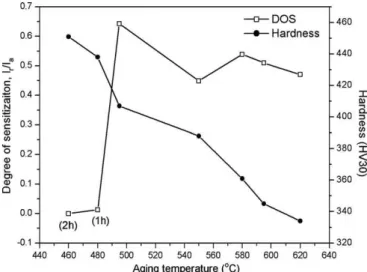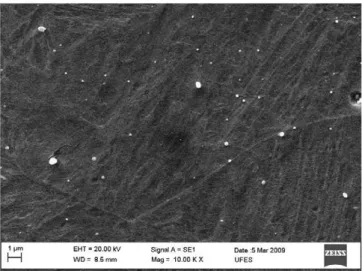Short Communication
Microstructure and intergranular corrosion resistance of UNS S17400 (17-4PH)
stainless steel
S.S.M. Tavares
a,*, F.J. da Silva
b, C. Scandian
b, G.F. da Silva
a, H.F.G. de Abreu
caUniversidade Federal Fluminense – Programa de Pós-graduação em Engenharia Mecânica (PGMEC), Rua Passo da Pátria, 156 – CEP 24210-240 – Niterói/RJ, Brazil bUniversidade Federal do Espírito Santo – Departamento de Engenharia Mecânica – Av. Fernando Ferrrari, 514 – CEP 29075-910 – Vitória/ES, Brazil
cUniversidade Federal do Ceará – Departamento de Engenharia Metalúrgica e Materiais – Campus do Pici, Bloco 702 – CEP 60455-760 – Fortaleza/CE, Brazil
a r t i c l e
i n f o
Article history:
Received 22 April 2010 Accepted 8 July 2010 Available online 13 July 2010
Keywords:
A. Stainless steel B. SEM B. XRD
C. Intergranular corrosion
a b s t r a c t
UNS S17400 or 17-4PH is a precipitation hardening martensitic stainless steel with many industrial appli-cations. Quite different mechanical properties can be produced in this material by varying the aging tem-perature. In this work, the influence of aging temperature on the intergranular corrosion susceptibility was evaluated by electrochemical and metallographic tests. The microstructural features were investi-gated by X-ray diffraction, optical and scanning electron microscopy. Intergranular chromium carbide precipitation occurs in specimens aged at high temperatures, although NbC carbides were also observed. The results obtained by double loop electrochemical potentiodynamic reactivation tests (DL-EPR) show that the susceptibility to intergranular corrosion resistance increases with the increase of aging temper-ature. Healing due to Cr diffusion in the 600–650°C range was not observed by DL-EPR tests.
Ó2010 Elsevier Ltd. All rights reserved.
1. Introduction
UNS S17400 steel, also known as 17-4PH, is a precipitation hardening martensitic stainless steel used in many applications, such as turbine foams in the aerospace industry[1], hydrometal-lurgy[2], oil and gas extraction and refinement. In nuclear plants this steel is used in light water reactors (LWRs)[3], pressurized water reactors and as parts of pumps and valves.
According to the usual practice of age hardening materials, the steel is solution treated at high temperatures and aged at lower temperatures. The solution treatment is carried out at 1040°C with oil quenching. This treatment results in a martensitic structure that can be hardened by subsequent aging. Aging temperatures vary from 480°C to 620°C. The material may be purchased in the fol-lowing conditions: A, H900, H925, H1025, H1075, H1100, H1150 and H1150-1150 (double aged). These codes correspond to com-mercial heat treatments related in Table 1 [4]. The condition H900 corresponds to aging at 480°C (900°F) for 1 h. At this condi-tion the material achieves the highest mechanical resistance due to the
e
-rich fine precipitation[2]. However, for some components, working in critical environmental conditions, the H900 treatment is not recommended because the material becomes drastically sus-ceptible to hydrogen embrittlement[5].The increase of aging temperature promotes overaging and aus-tenite formation. Components in H1100, H1150 and H1150-1150 conditions provide lower hardness but greater toughness[4].
Intergranular corrosion, frequently referred as sensitization, is one of the major problems in stainless steels. The formation of chromium carbides occurs by diffusion and is mainly concentrated in the grain boundaries, which results in chromium depletion in a narrow region round then. These regions become anodic in the presence of an electrolyte. The overall result of chromium carbides precipitation is an important deterioration of corrosion resistance [6].
The objective of this work was to evaluate the intergranular cor-rosion resistance of 17-4PH steel in the various heat treatment conditions. Microstructural investigation was carried out so as to explain and discuss the corrosion tests results.
2. Experimental
The material studied is a 17-4PH containing 15.40%Cr–4.22%Ni– 0.04%C–0.37%Si–0.025%P–0.005%S–0.28%Nb–3.49%Cu–0.62%Mn (wt%). Specimens were heat treated by oil quenching from 1040°C and aged at various temperatures. The aging temperatures and time intervals experimented in this work were: 460°C/2 h, 480°C/1 h (H900), 495°C/4 h (H925), 550°C/4 h (H1025), 580°C/ 4 h (H1075), 595°C/4 h (H1100), 620°C/4 h (H1150), 620°C/ 4 h + 4 h (H1150-1150), 620°C/66 h, 650°C/4 h and 650°C/12 h. As indicated, most of the conditions produced are commercial treatments related inTable 1.
0010-938X/$ - see front matterÓ2010 Elsevier Ltd. All rights reserved. doi:10.1016/j.corsci.2010.07.016
* Corresponding author. Tel.: +55 21 26295584; fax: +55 21 26295368.
E-mail address:ssmtavares@terra.com.br(S.S.M. Tavares).
Contents lists available atScienceDirect
Corrosion Science
The susceptibility to intergranular corrosion was evaluated by double loop electrochemical potentiodynamic reactivation tests (DL-EPR). This relatively new test method is replacing some con-ventional corrosion tests in the study of sensitization in stainless steels [7]. DL-EPR tests were conducted in a micro-AUTOLAB potentiostat–galvanostat. The conventional three cell electrode was assembled with working electrode, Pt foil as auxiliary elec-trode, and saturated calomel electrode (SCE) as reference. The working electrode was constructed using the 17-4PH specimens embedded in epoxy resin, ground with 400 emery paper, degreased with alcohol and cleaned in water. The tests were initiated after steady-state open circuit potential (Eoc) had been achieved. The po-tential was increased in the anodic direction at 1 mV s 1up to the potential of 0.3 VSCEwas reached. Then, the scan was reversed, maintaining the same sweeping rate in the cathodic direction. The loss of corrosion resistance, i.e. the degree of sensitization (DOS), was evaluated from the ratioIr/Ia, whereIais the activation peak current of the anodic scan andIris the reactivation peak cur-rent observed in the reversed scan.
The DL-EPR test was initially developed for austenitic AISI 304 steels[8]using a 0.5 mol L 1H
2SO4+ 0.01 mol L 1KSCN solution as the electrolyte. The test may be applied to other types of stainless steels, but modifications in the original solution may be necessary. For instance, previous work on AISI 310 stainless steels[9]used a more aggressive solution composed of 2.0 mol L 1 H
2SO4+ 0.01 mol L 1KSCN.
Two electrolytes were tested to evaluate the 17-4PH martens-itic steel. Solution 1 is the standard solution used for austenmartens-itic AISI 304 steel (0.5 mol L 1H
2SO4+ 0.01 mol L 1KSCN). Solution 2 is a less aggressive solution composed of 0.25 mol L 1 H
2SO4+ 0.01 mol L 1KSCN.
Microstructural analysis was performed by light optical (LOM) and scanning electron microscopy (SEM). The specimens were ob-served after the DL-EPR test and after metallographic polishing and etching. Two metallographic etchings were used for LOM and SEM. Etch 1 consists of 95 mL + 5 mL + 1 g picric acid (Villela’s etching), and Etch 2 is an electrolytic etch (8 V, 90 s) conducted in 10 wt%
oxalic acid solution. X-ray diffraction analysis was carried out in a PHILLIPS X’Pert diffractometer operating with Mo tube.
3. Results and discussion
Table 2shows theIr/Iavalues obtained. As expected, theIr/Ia val-ues in all conditions were significantly higher in the tests carried out with the standard solution 1.
It is expected that the best corrosion resistance of martensitic stainless steels, including the precipitation hardening types, is ob-tained in the quenched or solution treated condition, since after quenching from 1000 to 1100°C the material has the maximum chromium content into solid solution in the fresh martensite.
There are two reasons for considering solution 1 excessively aggressive for DL-EPR tests with 17-4PH steel. Firstly, the solution treated specimen, which has the best corrosion resistance, shows a small reactivation peak when tested with solution 1.
Secondly,Ir/Iahigher than 1 is not an usual result in this type of test, and specimens aged at 620°C for 8 and 66 h tested with solu-tion 1 presentedIr/Iavalues of 1.002 and 1.220, respectively. TheIr must be lower than theIa, because it represents a fraction of the material which was not passivated, due to the chromium deple-tion. This region is reactivated in the reverse scan. In theory, the reactivation peak cannot be higher than the activation because the un-passivated areas cannot be higher than the total tested area of the material. However, the use of excessively aggressive test solutions may lead toIr/Iahigher than 1.
The results of the tests with solution 2 were more coherent, which indicates that this solution should be the standard electro-lyte for DL-EPR tests with 17-4PH steel.
Fig. 1a and b show the DL-EPR curves of the specimens H900 and H925 tested with solution 2, respectively. There is a drastic in-crease of the degree of sensitization (Ir/Ia) from H900 to H925.
Fig. 2shows the variation of the DOS (orIr/Ia) and the hardness with the aging temperature. In this figure the time of aging was 4 h except for specimens aged at 460°C (2 h) and 480°C (1 h). In these two heat treatment conditions the material shows a lower DOS and the higher hardness values. However, as pointed out, these two conditions are the most susceptible to hydrogen embrittlement[5]. The high DOS observed in specimens aged at 495°C and above means that the material becomes drastically susceptible to inter-granular corrosion[8].
Fig. 3a and b show images of the specimen H1100 (595°C/4 h) obtained with the optical microscope.Fig. 3a, was obtained just after the DL-EPR test with solution 2 andFig. 3b was obtained with
Table 2
DOS (Ir/Iaratio) measured in the DL-EPR tests.
Condition Solution 1 Solution 2
Solution treated 0.009 0.000
460°C – 2 h 0.009 0.000
480°C – 1 h (H900) 0.103 0.013 495°C – 4 h (H925) 0.836 0.630 550°C – 4 h (H1025) 0.655 0.449 580°C – 4 h (H1075) 0.793 0.539 595°C – 4 h (H1100) 0.807 0.510 620°C – 4 h (H1150) 0.881 0.470 620°C – 4 h + 4 h (H1150-1150) 1.002 0.455
620°C – 66 h 1.220 0.560
650°C – 4 h – 0.697
650°C – 12 h – 0.941 Fig. 1.Curves of potential versus logiobtained in DL-EPR tests with solution 2: (a) H900 (Ir/Ia= 0.013) and (b) H925 (Ir/Ia= 0.630).
Table 1
Commercial heat treatments for 17-4PH steel[4].
the specimen polished and etched (etch 2). These two images show that the specimen suffered severe intergranular attack, which is in accordance to its high DOS (Ir/Iaratio).
Fig. 4a–c show the scanning electron microscope (SEM) images for specimen H1100 (595°C/4 h).Fig. 4a and c are from the speci-men prepared with etch 2. The SEM analysis shows that, in fact, the chromium carbides were dissolved by the etching, resulting in the intergranular ‘‘ditches” observed. Some intergranular holes are also
Fig. 2.Variation of the degree of sensitization and hardness with the aging temperature.
Fig. 3.Microstructures of the specimen H1100: (a) after the DL-EPR test; (b) prepared with etch 2.
observed indicating that chromium carbides may also precipitate inside the grains.Fig. 4b was obtained with the specimen prepared with etch 1, which reveals the chromium carbides without remov-ing them.Fig. 4c shows the microstructure at a high magnification, where small, and spherical particles are also observed. Specimen H1150-1150 showed the same features observed in specimen H1100. In both specimens, analysis by energy dispersive spectros-copy (EDS) of the small spherical precipitates, show a high Nb con-tent (Fig. 5).
The main precipitates formed by Nb in stainless steels are NbC carbides, (Nb, Ti)N nitrides, and Fe2Nb (Laves phase). (Nb, Ti)N nitrides are very coarse and square particles. The Laves phase is an intermetallic compound of A2B-type with topologically close packed (TCP) structure[10]. Normally, it has an average diameter higher than NbC carbides, and both can be observed by SEM[11]. The work of Yamamoto et al.[10]showed that Laves phase type Fe2Nb would only precipitate in martensitic Fe–Cr–Ni–Nb steels with Nb contents equal or higher than 1 wt%. Considering the Nb content of the 17-4PH steel studied (0.28 wt%), and the great affin-ity of this element to carbon, the spherical Nb-rich particles ob-served inFig. 4c are more likely NbC carbides.
NbC carbides were also observed in the specimen quenched and aged at 480°C for 1 h (H900), as shown inFig. 6. At these condi-tions the grain boundaries do not contain the large chromium car-bides and the material is not sensitized.
The NbC carbides were also observed in the specimen quenched from 1040°C (solution treated). It is interesting to note that the NbC precipitation was not able to prevent the sensitization of the material during aging at temperatures equal or higher than 495°C. Some previous works suggest that martensitic stainless steels can be tempered below 400°C, or above 600°C[12,13]. The inter-val between 400 and 600°C is forbidden because it promotes embrittlement and sensitization due to Cr23C6precipitation. Cˇihal
[14] reported DL-EPR results from a quenched and tempered 15Cr17Ni2 martensitic steel, and found a decrease of the degree of sensitization with the increase of tempering temperature above 550°C. The material was almost completely healed after tempering at 620°C for 4 h[14]. The term ‘‘healing” refers to the recovery of intergranular corrosion resistance due to the Cr diffusion.
Specimens treated at 620 and 650°C were investigated to eval-uate if the material is able to be healed in the 600–650°C range. Analyzing the data presented in Table 2, the DOS of specimens aged at 620°C, and tested with solution 2, are in the same level of those aged at 595°C. The increase of aging time at 620°C caused a further increase of DOS, which is an indication that the material
does not undergo healing at this temperature. Moreover, the in-crease of aging temperature to 650°C caused the increase of DOS to 0.697, and increasing the aging time at this temperature from 4 to 12 h resulted in a DOS equal 0.941 with test solution 2. As a conclusion, the DL-EPR results found in this work suggest that the 17-4PH does not undergo at 620 and 650°C.
Although DL-EPR tests have been successfully used in some pre-vious works to study the healing effect[9,15], it should be interest-ing to confirm the results found in this work by means of other corrosion tests, such as immersion tests.
The formation of reverse austenite was another microstructural change observed in the 17-4PH steel during aging at high temper-atures. X-ray diffraction patterns inFig. 7show that small austen-ite peaks are firstly observed in the H1100 condition. These peaks increase with the increase of aging time and temperature becom-ing perfectly clear in the H1150-1150 condition. Austenite forma-tion during aging decreases the Cr diffusivity and may be one of the factors which contribute to the inability of the steel to show heal-ing in the 600–650°C range. Reverse austenite also contributes to the mechanical softening observed inFig. 2.
4. Conclusions
Specimens of 17-4PH steel which were solution treated showed a very low degree of sensitization. Similarly, specimens which
Fig. 5.EDS spectrum of small and spherical particles ofFig. 4c.
Fig. 6.Microstructure of specimen H900.
were solution treated and aged at 460°C for 2 h or 480°C for 4 h also presented very low degrees of sensitization.
Specimens aged at temperatures equal or higher 495°C showed high degrees of sensitization in the DL-EPR tests, indicating an important increase of intergranular corrosion susceptibility.
The microstructural analysis revealed that the material presents fine and spherical NbC carbides in solution treated and aged spec-imens, as a consequence of the Nb addition (0.28 wt%). However, this precipitation did not avoid the sensitization in the specimens aged at high temperatures.
The healing effect was not observed in the 600–650°C range. Austenite formation was observed in the specimens aged at 595°C and higher.
Acknowledgements
The authors acknowledge of the Brazilian research agencies (CAPES, FAPERJ and CNPq) for financial support.
References
[1] S.V. Raj, L.J. Ghosn, B.A. Lerch, M. Hebsur, L.M. Cosgriff, J. Fedor, Mechanical properties of 17-4PH stainless steel foam panels, Mater. Sci. Eng. A 456 (1–2) (2007) 305–316.
[2] P. Li, Q.-Z. Cai, B.-K. Wei, X.-Z. Zhang, Effect of aging temperature on erosion corrosion behaviour of 17-4PH stainless steel in dilute sulphuric acid solution, J. Iron Steel Res. Int. 13 (5) (2006) 73–78.
[3] J. Wang, H. Zou, C. Li, S. Qiu, B.-Y. Shen, The effect of microstructural evolution on hardening behaviour of 17-4PH stainless steel in long-term aging at 350°C, Mater. Charact. 57 (4–5) (2006) 274–280.
[4] Website<http://www.westyorkssteel.com/Product_Info/Stainless_Steel/174ph. htm>, available from 03.09.2009.
[5] S.S.M. Tavares, J.M. Pardal, L. Menezes, C.A.B. Menezes, C. d’Avila, Failure Analysis of PSV springs of 17-4PH steels, Eng. Fail. Anal. 16 (5) (2009) 1757– 1764.
[6] H.-E. Bühler, L. Gerlach, O. Greven, W. Bleck, The electrochemical reactivation test (ERT) to detect the susceptibility to intergranular corrosion, Corros. Sci. 45 (10) (2003) 2325–2336.
[7] M. Prohaska, H. Kanduth, G. Mori, R. Grill, G. Tischler, On the substitution of conventional corrosion tests by an electrochemical potentiokinetic reactivation test, Corros. Sci. 52 (5) (2010) 1582–1592.
[8] N. Lopez, M. Cid, M. Puiggali, I. Azkarate, A. Pelayo, Application of double loop elçectrochemical potentiodynamic reactivation test to austenitic and duplex stainless steels, Mater. Sci. Eng. A 229 (1–2) (1997) 123–128.
[9] S.S.M. Tavares, J.M. Pardal, V.C. da Costa, M.L.R. Ferreira, Microstructural changes and corrosion resistance of AISI 310S steel exposed to 600–800°C, Mater. Charact. 60 (6) (2009) 573–578.
[10] K. Yamamoto, Y. Kimura, F.-G. Wei, Y. Mishima, Design of Laves phase strengthened ferritic heat resisting steels in Fe–Cr–Nb(–Ni) system, Mater. Sci. Eng. A 329–331 (2002) 249–254.
[11] G. Dimmler, P. Weinert, E. Kozeschnik, H. Cerjak, Quantification of the Laves phase in advanced 9–12%Cr steels using a standard SEM, Mater. Charact. 51 (5) (2003) 341–352.
[12] ASM Metals Hand Book – Heat Treatment, vol. 4, ASM International, 1991. [13] F.B. Pickering, Physical Metallurgy and the Design of Steels, Applied Science
Publishers Ltd., London, 1978. 275 p.
[14] V. Cˇihal, R. Štefec, On the development of the electrochemical potentiokinetic method, Electrochim. Acta 46 (2001) 3867–3877.


